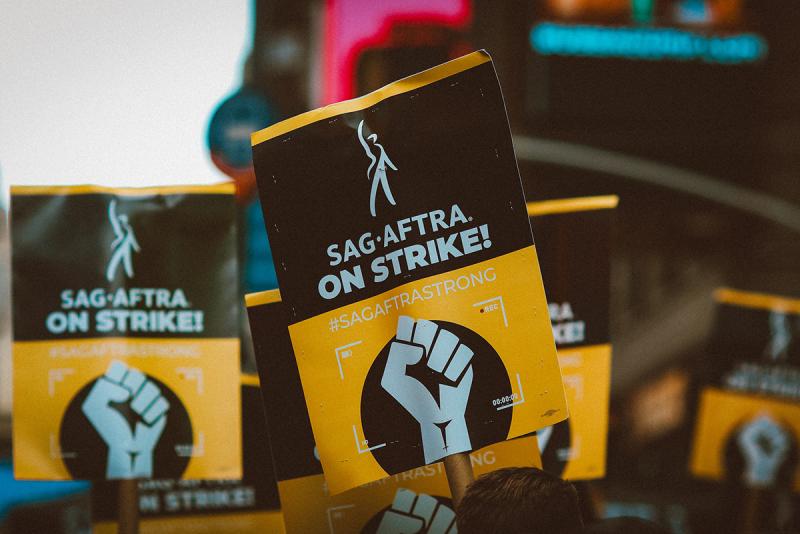Why This Has Been a Year of Labor Union Reckoning and Resurgence

SAG-AFTRA, the Hollywood actors union, just reached a tentative agreement with studios to end their strike.
Recent high-profile labor union strikes in a variety of sectors including Hollywood writers’ and actors’ unions, the United Autoworkers (UAW) and Kaiser Permanente health care workers have grabbed headlines and proven to be a significant trend in 2023. Some labor experts cite increasing wealth inequality, a strong labor market, inflation and growing support for organized labor as factors that continue to strengthen unions’ resolve.
The CAHSS newsroom asked Teaching Professor Paula Cole and Teaching Assistant Professor Tamara Trafton, both from the Department of Economics at the College of Arts, Humanities & Social Sciences, for their views on what this means for the economy, the greater DU community and the daily lives of workers and consumers.
What are the most predominant causes leading up to a potential rise in labor union actions and strikes in the United States?
Cole: We don’t really know yet if strikes increased in 2023 or are just back to pre-pandemic levels. The Bureau of Labor Statistics (BLS) data for 2023 isn’t out yet but in 2022 the number of work stoppages was 23, in 2021 it was 16, in 2020 it was eight, while in 2018 and 2019 it was 20 and 25, respectively. For perspective, there were only seven work stoppages in 2017 and the last time we got above 20 was 2007, right before the Great Recession.
That said, I find it interesting that we are seeing this visible increase in strikes across industries. In terms of underlying causes, three major factors come to mind — inequality, inflation and the pandemic.
The level of income inequality in the U.S. has not been this high since the pre-Depression era. Worker productivity over the past 30-40 years has continued to rise but wages have not kept pace. This has led to greater wealth disparity, with a handful of folks, including CEOs of large companies, seeing their wealth grow exponentially.
Something that has been missed a bit in the larger media coverage is the complexity of the inflation problem and how it was generated from the pandemic’s supply chain problems. The delay in procuring the chip needed in manufacturing cars, for example, caused the price of new cars to rise. However, many companies didn’t have that same kind of supply chain shortage and Brookings Institution and other research suggests that well-known companies may have been using the cover of the pandemic to increase prices and shareholder profits.
The Federal Reserve’s efforts to target inflation by raising interest rates and shrinking the economy has had a more negative impact on those who have less income and typically results in higher unemployment. Nevertheless, unemployment remains low and workers are in the best bargaining position that they’ve been in for a long time. Many have been pushing the narrative that people don’t want to work when really, most people have jobs. According to the BLS, from 2021-22, the number of workers who had a primary full-time job and a secondary part-time job rose by 400,000. The problem is increased prices impact low-income workers and those at the top differently.
Trafton: I agree with Paula that a key underlying cause of the increase in strikes in the United States is income inequality which is much higher in the U.S. than what is typical in most “developed” countries. Real household income at the 10th percentile has barely changed in five decades while at the 95th percentile, real household income has close to doubled. Looking at current trends, real median household income fell between 2018 and 2022 by about $4,000.
Rising inequality over time and recently falling real median income leads to a pretty large percentage of the population that is worried about their income, prompting some to action.
How do these strikes differ from strikes in the past?
Cole: I’m seeing a different emphasis on strategy and scope. The autoworkers have been much more strategic. Rather than all the plants striking at the same time, they spread it out. When they announced they were going on strike they didn’t say which plants would be affected, which kept individual companies guessing as to where they might be short workers. The UAW started small with strikes at a few plants for each of the automakers and increased the number of plants or switched up those on strike, which also spread the burden out between companies, locations and workers. [The UAW recently reached a tentative deal with GM following agreements with Ford and Stellantis, effectively ending its strikes and scoring significant pay and benefit increases for workers at all three automakers.]
Trafton: One big difference is more support for unions. A sitting president joined autoworkers on the picket line compared to former President Ronald Reagan firing striking air traffic controllers in the early 1980s.
What are some common themes that unions across diverse industries are bargaining for?
Cole: Besides pay I would add technology. Hollywood has helped all workers by trying to address how AI impacts their work. Technology also showed up in the autoworkers strike. One of their bargaining points related to where battery manufacturing plants would be located and whether workers who work in battery manufacturing plants would be covered under union contracts. They’ve been looking toward the shift away from gasoline-powered toward battery-powered cars and making sure workers can transition and receive the same union benefits.
One of the issues in the Kaiser strike was understaffing and that’s a problem throughout the healthcare industry. Some pharmacies across the country are struggling with the same issue, spurring a three-day walkout at some CVS and Walgreens stores. A typical pharmacy might just have two pharmacists at a particular location so, if one pharmacist is on vacation and another gets sick, they can’t function and must shut down.
Trafton: Given the pandemic, health and safety concerns are very prominent on unions’ radar. Sick pay is showing up as a common theme as are health care benefits in general. And as people see real median income falling, concerns about retirement benefits are becoming even more important.
Do gains made because of these strikes have a ripple effect; encourage other unions to bargain over similar wage and working condition issues in the future?
Cole: Yes. And if you look at 2022 BLS data on how wages for union and non-union wages compare, workers 25 years or older who were part of a union earned $133 more a week than non-union members. In general, being part of a union means you’re going to have higher wages and benefits. And that’s still true despite the long-term historical decline in union membership. Even though the majority of workers are not union members, successful union negotiations to raise pay and benefits for their members can put pressure on non-unionized companies to increase pay and benefits for their employees.
The Kaiser union’s success will have repercussions for other health care providers and facilities in Colorado in terms of competition for attracting nurses, for example. Substantially higher wages at Kaiser put pressure on other employers to attract and retain more nurses and health care workers.
Trafton: I do think these strikes are increasing public awareness of pay and benefits in industries that the public might not have thought about. It’s easy to think of movie stars as being part of the 1% but the WGA and SAG-AFTRA actions have made clear how inequitable the industry is. It’s making the public think about things like residuals and streaming. And for employers in general, witnessing strikes makes them think about the possibility and repercussions of that happening with their own workers.
How have these strikes impacted all of us as consumers?
Cole: The effects on health care were probably the most visible. Members might have experienced temporary closure or longer waits for pharmacy and lab services, but staff shortages meant that we were already waiting longer to get health care. Understaffing and turnover, respectively, were the top two issues in the Kaiser union’s recent strike. If you’re putting in all these hours but then members are angry with you because they must wait longer to get care, that affects both consumers and workers.
In terms of the autoworkers, I think the industry has rebounded from its supply chain problems, but we still have not gotten back to pre-pandemic automobile market realities in terms of availability and prices of cars. The autoworkers’ strike slowed down production and the release of new cars and automobile parts if your car needs fixing.
As a result of the Hollywood strikes, obviously we’re going to have to wait longer for new movies and TV episodes. While higher wages and benefits may ultimately lead to price increases for consumers, it’s important to remember that higher wages cycle back into the local community because higher paid workers can do things that they had to cut out like go to movies, eat out or spend more on groceries and clothing.
When I think of Colorado in terms of the need for higher wages, I automatically think of our high housing costs and the impact that it has on everyone. Whether we’re talking ownership or rental prices, increased wages will make it easier to be housed.
Trafton: It can be easy to focus on disruptions in production and therefore consumption, but it doesn’t seem fair to me to expect, for example, a health care worker who’s overworked and stressed about providing for their family to come to work anyway rather than fight to provide for their family’s wellbeing.
The strikes have already led to fairer contracts for some workers which enables them to provide better for themselves and their families. I think the ultimate impact on consumers’ daily lives will come in the form of better encounters with workers when they return to work, if strikes are successful.
Is there any labor union organizing happening on college campuses in Colorado or elsewhere?
Cole: There are several campuses where adjunct faculty and graduate students have been doing some picketing and — depending on their ability to unionize — trying to push back around wages. The adjunct faculty and graduate students have a lot to gain and less to lose.
Trafton: Recently at CU Boulder, staff, faculty and student workers protested over wages and working conditions, in particular conditions for the more precarious workers like adjuncts and temporary staff. In Colorado many public sector employees are in a difficult spot while state legislation is still preventing them from effectively bargaining. Colorado bill SB23-111, signed by the governor in June, provides some protections around labor organizing for public workers, but does not require employers to bargain with newly organized labor.
Do you see more strikes and union organizing going forward?
Cole: Yes. Right now, union workers remain in one of the best bargaining positions they’ve been in in a long time. If more unions continue to succeed in their bargaining that’s going to put even more pressure on other companies to increase wages.
But larger, unforeseen conditions could change that. I’m thinking right now about what’s happening with Israel and Hamas and the issues around climate crisis. And something like the pandemic that disrupted everything could arise. But for the immediate future, we’re likely to see workers continuing to negotiate for better pay and conditions, whether they’re part of a union or not.
Trafton: Prediction is a tough game. There’s an old joke that economists have predicted nine out of the last five recessions.







